Inverse Design and Numerical Investigations of an Ultra-Compact Integrated Optical Switch Based on Phase Change Material
Abstract
:1. Introduction
2. Materials and Methods
2.1. Device Structure and Working Principle
2.2. Inverse Design Method
3. Results
3.1. Numerical Evaluation
3.2. Experimental Feasibility
4. Conclusions
Author Contributions
Funding
Data Availability Statement
Conflicts of Interest
References
- Zhu, S.; Yu, T.; Xu, T.; Chen, H.; Dustdar, S.; Gigan, S.; Gunduz, D.; Hossain, E.; Jin, Y.; Lin, F.; et al. Intelligent Computing: The Latest Advances, Challenges, and Future. Intell. Comput. 2023, 2, 0006. [Google Scholar] [CrossRef]
- Xu, X.; Ren, G.; Feleppa, T.; Liu, X.; Boes, A.; Mitchell, A.; Lowery, A.J. Self-calibrating programmable photonic integrated circuits. Nat. Photonics 2022, 16, 595–602. [Google Scholar] [CrossRef]
- Siew, S.Y.; Li, B.; Gao, F.; Zheng, H.Y.; Zhang, W.; Guo, P.; Xie, S.W.; Song, A.; Dong, B.; Luo, L.W.; et al. Review of silicon photonics technology and platform development. J. Light. Technol. 2021, 39, 4374–4389. [Google Scholar] [CrossRef]
- Helkey, R.; Saleh, A.A.; Buckwalter, J.; Bowers, J.E. High-performance photonic integrated circuits on silicon. IEEE J. Sel. Top. Quantum Electron. 2019, 25, 1–15. [Google Scholar] [CrossRef]
- Xie, J.; Ye, W.; Zhou, L.; Guo, X.; Zang, X.; Chen, L.; Zhu, Y. A review on terahertz technologies accelerated by silicon photonics. Nanomaterials 2021, 11, 1646. [Google Scholar] [CrossRef]
- Delaney, M.; Zeimpekis, I.; Du, H.; Yan, X.; Banakar, M.; Thomson, D.J.; Hewak, D.W.; Muskens, O.L. Nonvolatile programmable silicon photonics using an ultralow-loss Sb2Se3 phase change material. Sci. Adv. 2021, 7, eabg3500. [Google Scholar] [CrossRef]
- Peng, Z.; Feng, J.; Yuan, H.; Cheng, W.; Wang, Y.; Ren, X.; Cheng, H.; Zang, S.; Shuai, Y.; Liu, H.; et al. A non-volatile tunable ultra-compact silicon photonic logic gate. Nanomaterials 2022, 12, 1121. [Google Scholar] [CrossRef]
- Zhu, H.; Lu, Y.; Cai, L. High-Performance On-Chip Racetrack Resonator Based on GSST-Slot for In-Memory Computing. Nanomaterials 2023, 13, 837. [Google Scholar] [CrossRef] [PubMed]
- Zhang, Y.; Fowler, C.; Liang, J.; Azhar, B.; Shalaginov, M.Y.; Deckoff-Jones, S.; An, S.; Chou, J.B.; Roberts, C.M.; Liberman, V.; et al. Electrically reconfigurable non-volatile metasurface using low-loss optical phase-change material. Nat. Nanotechnol. 2021, 16, 661–666. [Google Scholar] [CrossRef] [PubMed]
- Chen, X.; Xue, Y.; Sun, Y.; Shen, J.; Song, S.; Zhu, M.; Song, Z.; Cheng, Z.; Zhou, P. Neuromorphic Photonic Memory Devices Using Ultrafast, Non-Volatile Phase-Change Materials. Adv. Mater. 2022, 2022, 2203909. [Google Scholar] [CrossRef] [PubMed]
- Fan, X.; Kang, Q.; Ai, H.; Guo, K.; Guo, Z. Full-space metasurface in mid-infrared based on phase change material of VO2. J. Opt. 2022, 1–9. [Google Scholar] [CrossRef]
- Lyu, X.; Heßler, A.; Wang, X.; Cao, Y.; Song, L.; Ludwig, A.; Wuttig, M.; Taubner, T. Combining Switchable Phase-Change Materials and Phase-Transition Materials for Thermally Regulated Smart Mid-Infrared Modulators. Adv. Opt. Mater. 2021, 9, 2100417. [Google Scholar] [CrossRef]
- Kang, T.; Fan, B.; Qin, J.; Yang, W.; Xia, S.; Peng, Z.; Liu, B.; Peng, S.; Liang, X.; Tang, T.; et al. Mid-infrared active metasurface based on Si/VO 2 hybrid meta-atoms. Photonics Res. 2022, 10, 373–380. [Google Scholar] [CrossRef]
- Manolis, A.; Faneca, J.; Bucio, T.D.; Baldycheva, A.; Miliou, A.; Gardes, F.; Pleros, N.; Vagionas, C. Non-volatile integrated photonic memory using GST phase change material on a fully etched Si3N4/SiO2 waveguide. In Proceedings of the CLEO: Science and Innovations, Optica Publishing Group, Washington, DC, USA, 10–15 May 2020; p. STh3R–4. [Google Scholar]
- Miyatake, Y.; Ho, C.P.; Pitchappa, P.; Singh, R.; Makino, K.; Tominaga, J.; Miyata, N.; Nakano, T.; Sekine, N.; Toprasertpong, K.; et al. Mid-infrared Non-volatile Compact Optical Phase Shifter Based on Ge2Sb2Te5. In Proceedings of the 2020 European Conference on Optical Communications (ECOC), Brussels, Belgium, 6–10 December 2020; IEEE: Piscataway, NJ, USA, 2020; pp. 1–4. [Google Scholar]
- Zhou, L.; Zhang, H.; Hu, H.; Wang, N.; Lu, L.; Rahman, B.; Chen, J. Non-volatile silicon photonic devices enabled by phase change material. In Proceedings of the 2019 18th International Conference on Optical Communications and Networks (ICOCN), Huangshan, China, 5–8 August 2019; IEEE: Piscataway, NJ, USA, 2019; pp. 1–3. [Google Scholar]
- Guo, P.; Sarangan, A.M.; Agha, I. A review of germanium-antimony-telluride phase change materials for non-volatile memories and optical modulators. Appl. Sci. 2019, 9, 530. [Google Scholar] [CrossRef]
- Zhang, J.; Zhang, Y.; Hong, Q.; Xu, W.; Zhu, Z.; Yuan, X. Near-infrared rewritable, non-volatile subwavelength absorber based on chalcogenide phase change materials. Nanomaterials 2020, 10, 1222. [Google Scholar] [CrossRef]
- Li, W.; Cao, X.; Song, S.; Wu, L.; Wang, R.; Jin, Y.; Song, Z.; Wu, A. Ultracompact High-Extinction-Ratio Nonvolatile On-Chip Switches Based on Structured Phase Change Materials. Laser Photonics Rev. 2022, 16, 2100717. [Google Scholar] [CrossRef]
- Wu, D.; Yang, X.; Wang, N.; Lu, L.; Chen, J.; Zhou, L.; Rahman, B.A. Resonant multilevel optical switching with phase change material GST. Nanophotonics 2022, 11, 3437–3446. [Google Scholar] [CrossRef]
- Chen, L.; Ye, H.; Liu, Y.; Wu, D.; Ma, R.; Yu, Z. Numerical investigations of an optical switch based on a silicon stripe waveguide embedded with vanadium dioxide layers. Photonics Res. 2017, 5, 335–339. [Google Scholar] [CrossRef]
- Zhou, W.; Cheng, Z.; Chen, X.; Xu, K.; Sun, X.; Tsang, H. Subwavelength engineering in silicon photonic devices. IEEE J. Sel. Top. Quantum Electron. 2019, 25, 1–13. [Google Scholar] [CrossRef]
- D’Mello, Y.; Reshef, O.; Bernal, S.; El-fiky, E.; Wang, Y.; Jacques, M.; Plant, D.V. Integration of periodic, sub-wavelength structures in silicon-on-insulator photonic device design. IET Optoelectron. 2020, 14, 125–135. [Google Scholar] [CrossRef]
- Ali, A.; Mitra, A.; Aïssa, B. Metamaterials and metasurfaces: A review from the perspectives of materials, mechanisms and advanced metadevices. Nanomaterials 2022, 12, 1027. [Google Scholar] [CrossRef] [PubMed]
- Mao, S.; Hu, J.; Jiang, W. Inverse Designed Silicon Mode Converters Based on the Direct Binary Search Algorithm. In Proceedings of the 2022 IEEE 14th International Conference on Advanced Infocomm Technology (ICAIT), Chongqing, China, 8–10 July 2022; IEEE: Piscataway, NJ, USA, 2022; pp. 243–246. [Google Scholar]
- Li, P.; Zhang, T.; Xu, K. Inverse design of multifunctional metamaterial based on modified direct binary search algorithm. In Proceedings of the AOPC 2021: Micro-optics and MOEMS, Beijing, China, 24 November 2021; SPIE: Bellingham, WA, USA, 2021; Volume 12066, pp. 287–292. [Google Scholar]
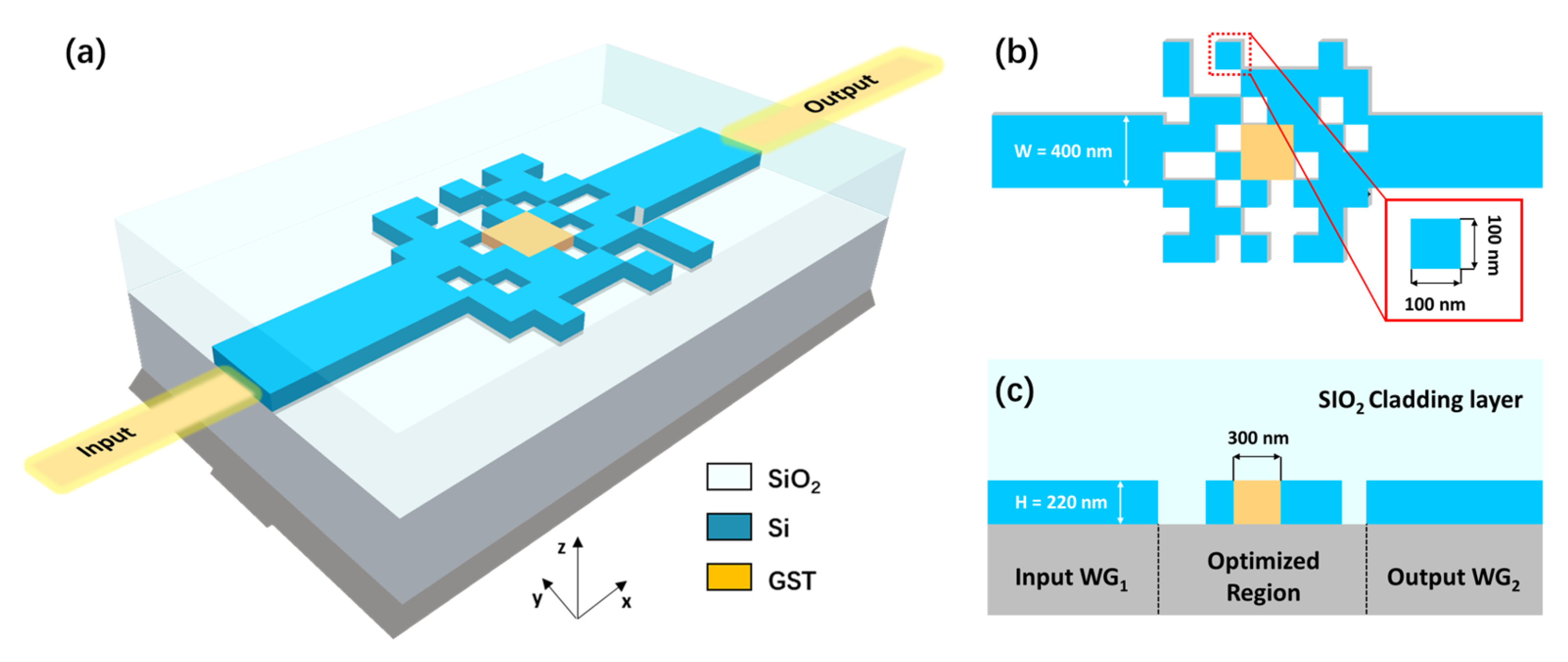

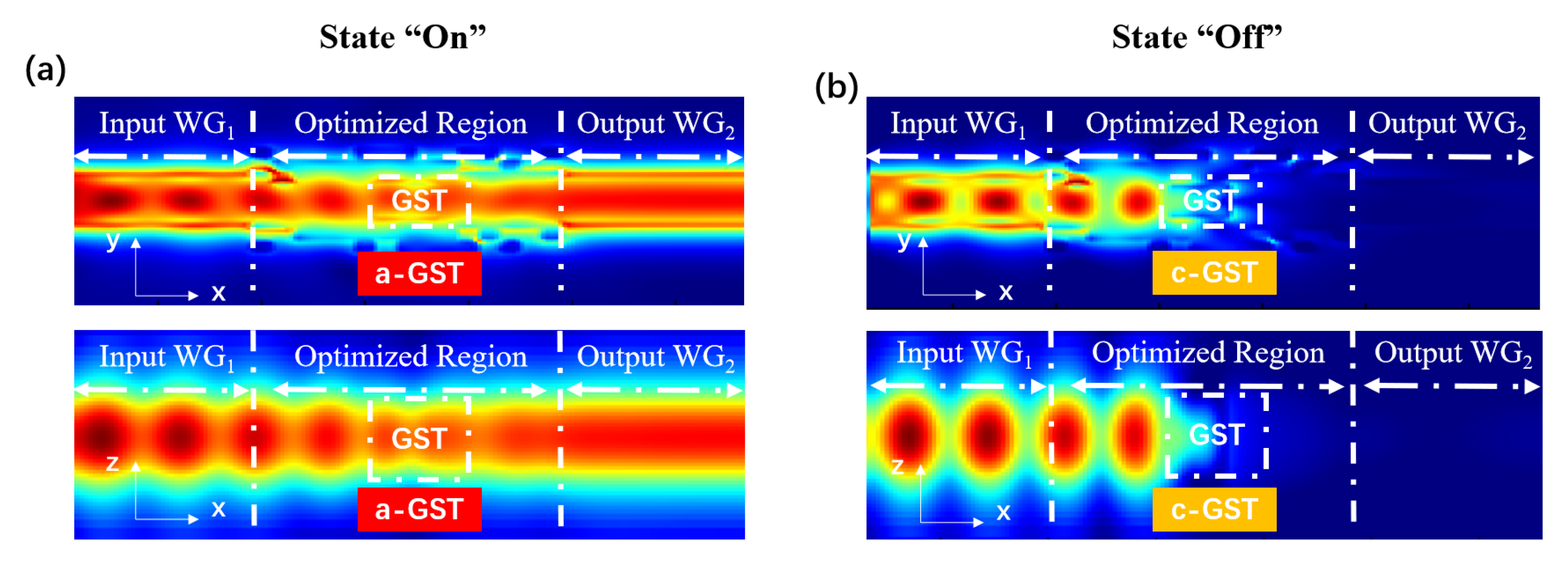
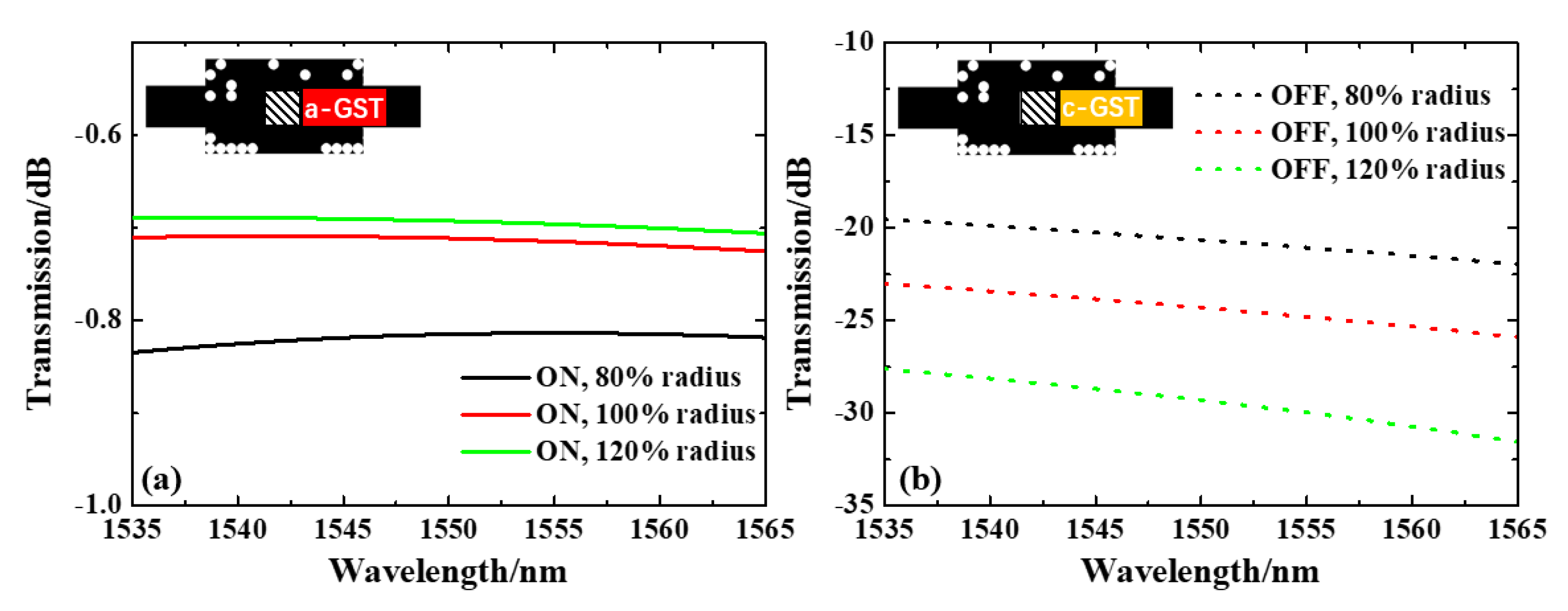
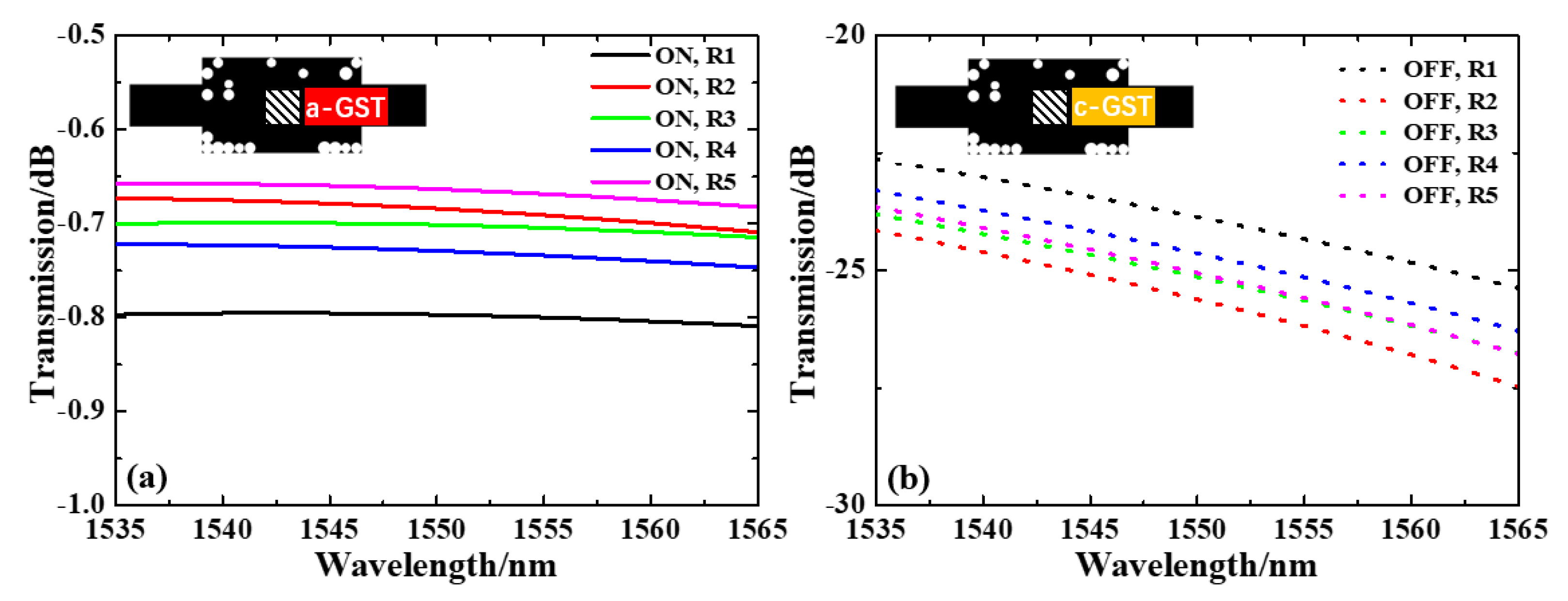
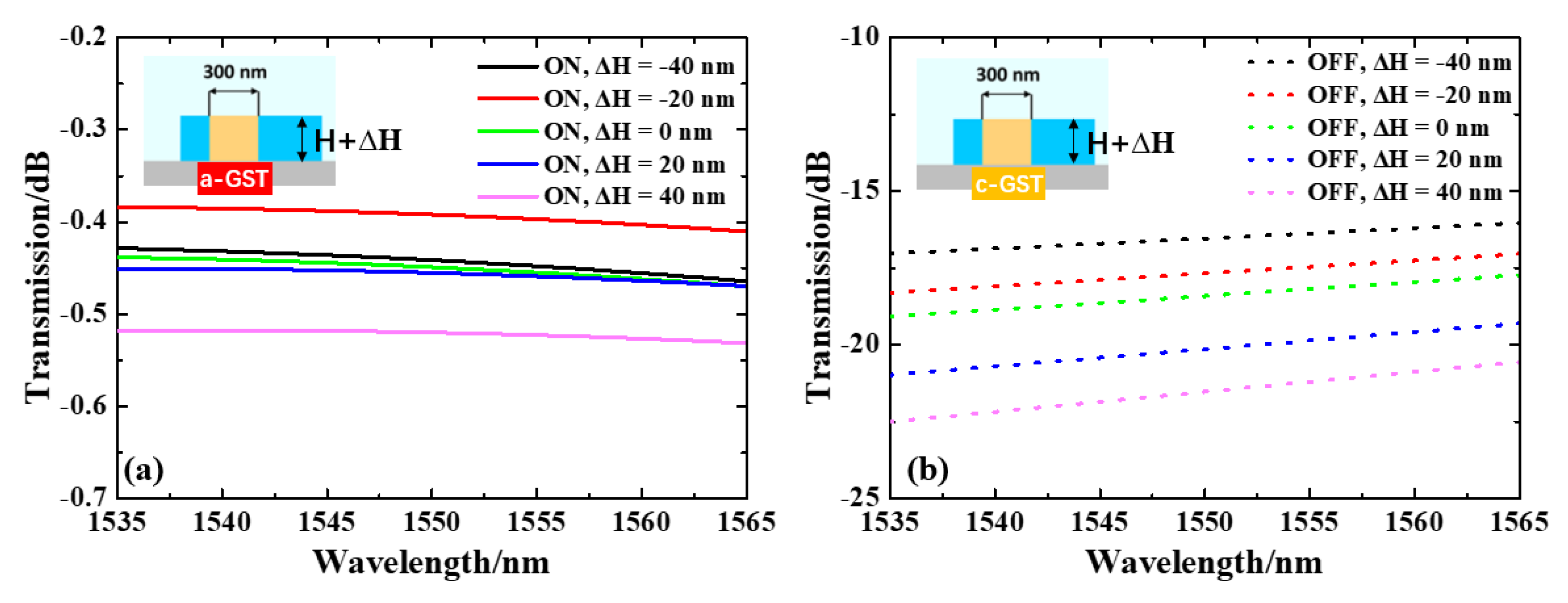

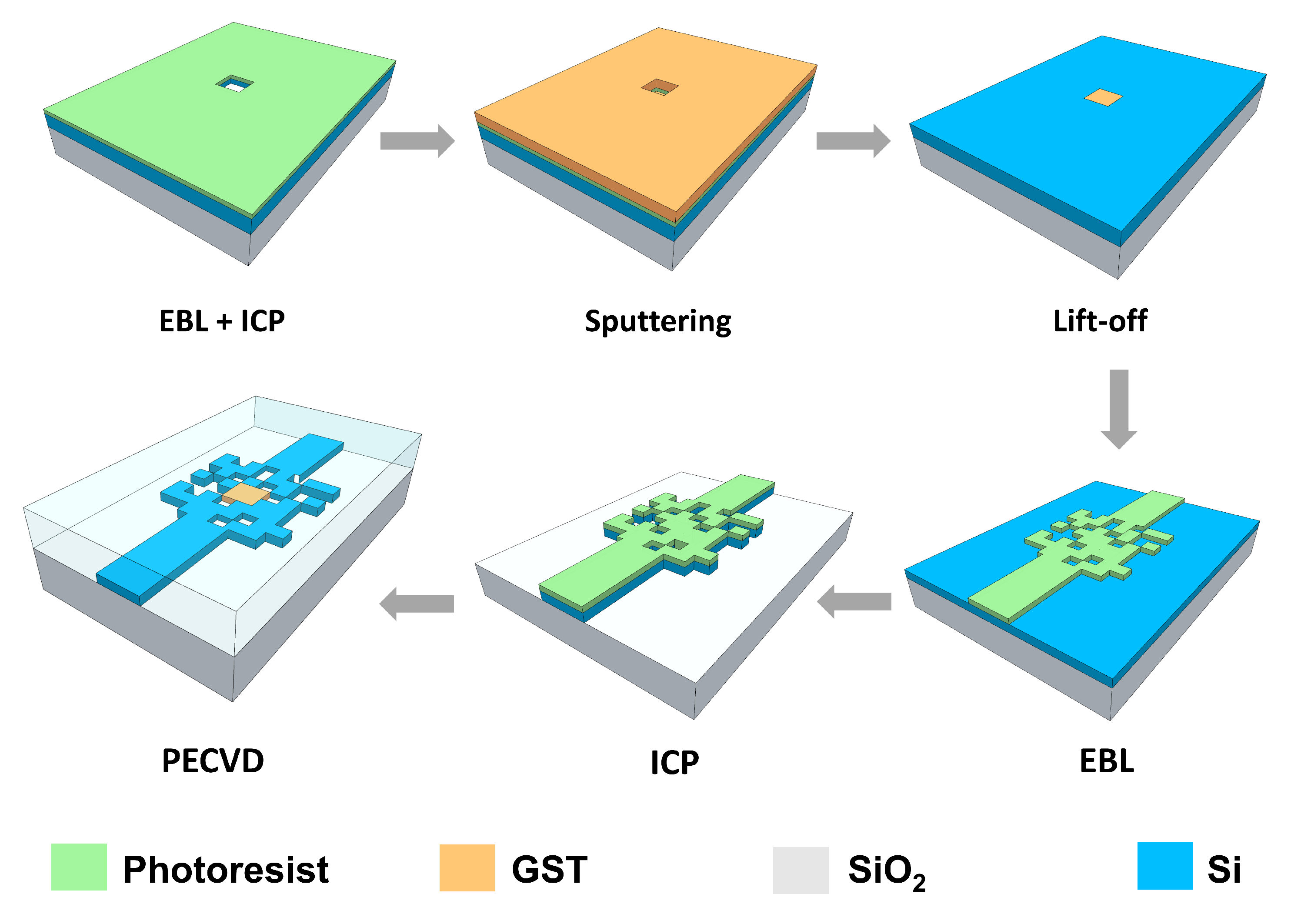
| FOM | 1550 nm | 1535–1565 nm | |||
|---|---|---|---|---|---|
| IL (dB) | ER (dB) | IL (dB) | ER (dB) | ||
| S1 | 0.882 | 0.44 | 16.5 | 0.43∼0.48 | 16.5∼16.6 |
| S2 | 0.887 | 0.45 | 18.0 | 0.44∼0.47 | 17.3∼18.6 |
| S3 | 0.833 | 0.96 | 23.4 | 0.95∼1.00 | 23.1∼23.5 |
Disclaimer/Publisher’s Note: The statements, opinions and data contained in all publications are solely those of the individual author(s) and contributor(s) and not of MDPI and/or the editor(s). MDPI and/or the editor(s) disclaim responsibility for any injury to people or property resulting from any ideas, methods, instructions or products referred to in the content. |
© 2023 by the authors. Licensee MDPI, Basel, Switzerland. This article is an open access article distributed under the terms and conditions of the Creative Commons Attribution (CC BY) license (https://creativecommons.org/licenses/by/4.0/).
Share and Cite
Yin, K.; Gao, Y.; Shi, H.; Zhu, S. Inverse Design and Numerical Investigations of an Ultra-Compact Integrated Optical Switch Based on Phase Change Material. Nanomaterials 2023, 13, 1643. https://doi.org/10.3390/nano13101643
Yin K, Gao Y, Shi H, Zhu S. Inverse Design and Numerical Investigations of an Ultra-Compact Integrated Optical Switch Based on Phase Change Material. Nanomaterials. 2023; 13(10):1643. https://doi.org/10.3390/nano13101643
Chicago/Turabian StyleYin, Kun, Yang Gao, Hao Shi, and Shiqiang Zhu. 2023. "Inverse Design and Numerical Investigations of an Ultra-Compact Integrated Optical Switch Based on Phase Change Material" Nanomaterials 13, no. 10: 1643. https://doi.org/10.3390/nano13101643





